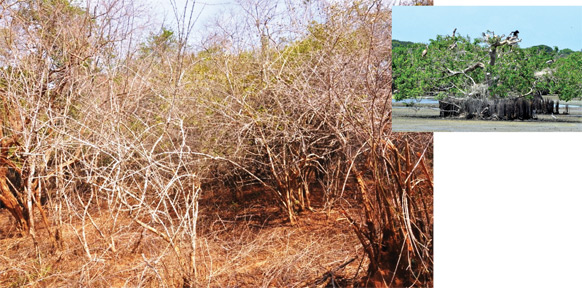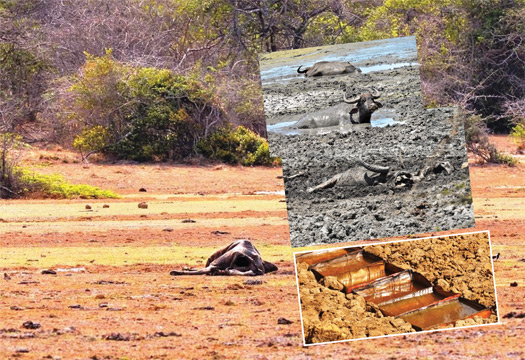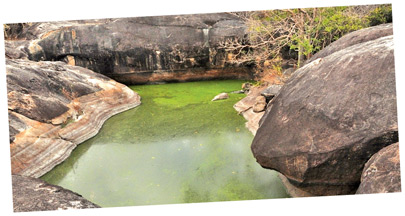|
Tourism industry:
Stakeholders must show: corporate Environment Responsibility
By Gamini Warushamana
The prolonged drought has now affected all economic activity in the
Dry Zone. Since droughts are frequent and disastrous, sustainable
programs to minimise its impact have become vital.
 The plight of the people suffering without water for drinking
purposes and farmers losing crops are highlighted in the media and the
government, the public, corporate and other charities have launched
various initiatives to support them. However, wildlife in national parks
and forest reserves are also suffering without any support. The plight of the people suffering without water for drinking
purposes and farmers losing crops are highlighted in the media and the
government, the public, corporate and other charities have launched
various initiatives to support them. However, wildlife in national parks
and forest reserves are also suffering without any support.
Kumana National Park in the Eastern Province has felt the impact of
the drought severely and we heard that wild animals are dying due to
lack of water and food. However, on August 18, the day we reached Kumana,
scattered showers had started and it was raining from Moneragala to
Pottuvil and in Arugam Bay.
Hard hit
The rain was insignificant and on the following day the whole park
and the lakes remained dry.
According to deputy park warden P. Sanjeewa herbivorous animals in
the park have been hard hit by the drought and animals such as elephants
which can walk long distances in search of water and food or migrate to
safe places are less affected.
The animals that have limited habitat areas and cannot walk long
distances suffer severely.
Among them the plight of buffaloes is tragic and dozens of carcasses
could be seen in dried and cracked beds of lakes.
All the lakes at the Kumana National Park have dried up and only a
little water remains in the Kumana Villu wetland.
 Buffaloes and all other animals are now scattered around the Villu
but unfortunately water is out of reach for some small animals like
deer. Buffaloes and all other animals are now scattered around the Villu
but unfortunately water is out of reach for some small animals like
deer.
Arugam Bay
Buffaloes in the Kumana Villu too are dying in pools of mud. The
water level is not sufficient for them to cool their overheated bodies
or for thermo-regulation.
The other reason may be lack of food. Usually buffaloes eat a large
quantity of grass but now they have nothing to eat.
It might be as a result of disease, related to heat and drought but
so far no study has been done.
Kumana is a paradise for bird watching and being in close to Arugam
Bay beach, a large number of local and foreign tourists visit Kumana
throughout the year. The park earns sufficient money to develop
infrastructure to protect its wildlife during this type of natural
catastrophe but the facilities are inadequate.
The Department of Wildlife has constructed small ponds and supplies
water by bowser.
There are eight ponds in and outside the park but it is not
sufficient for all the animals. Some true nature lovers have donated
money to construct ponds and doctors of the Ampara district hospital are
constructing one. The cost of a pond is around Rs.120,000.
Only two bowsers are available to supply water and due to the terrain
and condition of the roads, tractor bowsers are better suited, park
officials said.
There are several large natural ponds in rocks that can store a large
quantity of water.
Kumbukkan Oya on the borders of Block 2 of the Yala National Park is
one source but water cannot be carried to the other end of the park due
to a dilapidated bridge.
|

Natural ponds in rocks that can store a large quantity of
water. |
Locations have been identified for three tube wells but financial
constraints have delayed construction. The cost of a tube well is around
Rs. 35,000.
Natural beauty
As the tourism industry is booming all stakeholders of the industry
are reaping its fruits and what all of them sell the natural beauty of
this land.
Therefore, corporates too have a responsibility to protect them and
ensure their sustainability.
Kumana wildlife which are sold over and again by all tourism industry
stakeholders are now in need of support. It is also time for true nature
lovers to demonstrate their commitment. Park authorities later said that
the rains that started on August 18 did not continue and the situation
at the park is becoming worse. With the increase in water level at
Kumbukkan Oya, the water level in Kumana Villu too has increased a
little.
It is clear that without outside support there is no relief for the
wild animals because we have to wait another two months for North East
monsoon rains. |

